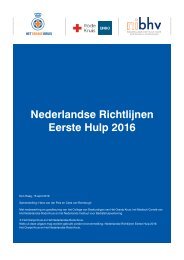Thesis-Anne-Vos-Masters-SBR-and-EU-Law-3
Thesis-Anne-Vos-Masters-SBR-and-EU-Law-3
Thesis-Anne-Vos-Masters-SBR-and-EU-Law-3
You also want an ePaper? Increase the reach of your titles
YUMPU automatically turns print PDFs into web optimized ePapers that Google loves.
concerning energy projects, in which appellants invoked the precautionary principle before the<br />
Afdeling. In a recent case before the Afdeling, the issue of the 'adaptive licensing approach’ <strong>and</strong><br />
the precautionary principles were discussed. 361 Here, it concerned gas exploration (on the basis of<br />
the Mining Act) under the Waddenzee. Appellants invoked the precautionary principle, because<br />
they were of the opinion that the gas extraction contained too many uncertainties. The Afdeling did<br />
not address the question of whether or not the precautionary principle was breached, but instead<br />
focused on the fact that the project, due to the adaptive licensing approach, provided for a<br />
surveillance system on the basis of which could always be intervened. 362 This was sufficient,<br />
according to the Afdeling. In the annotation to this case, Van der Velde considers that the<br />
exportation of the precautionary principle from the Nbw-1998 to outside the conservation law<br />
seems arguable. 363 Otherwise, he argues, this would mean that animals or people living near a<br />
gas-project, located in a Natura-2000 area, are better off than if the project is not located in such<br />
an area. Also in other cases, the Afdeling has not yet addressed the question on the meaning of<br />
the precautionary principle outside the Nbw-1998. 364 The Afdeling has addressed the adaptive<br />
licensing approach (an application of the precautionary principle), although developed in<br />
conservation cases, in some cases concerning seismicity in the Bergermeer. 365 This could be an<br />
indication that the Afdeling also sees an application of the principle outside the Nbw-1998, which<br />
would of course also be in line with the <strong>EU</strong> legislation <strong>and</strong> case law.<br />
5.7 Principle of environmental policy: prevention principle<br />
5.7.1 <strong>EU</strong> level<br />
The principle that preventive action should be taken first occurred in the arbitration case Trial<br />
Smelter between the USA <strong>and</strong> Canada, which case dealt with international law. Here, the Tribunal<br />
has found that<br />
[U]nder the principles of international law, as well as of the law of the United States, no State has the<br />
right to use or permit the use of its territory in such a manner as to cause injury by fumes in or to the<br />
territory of another or the properties or persons therein, when the case is of serious consequence<br />
<strong>and</strong> the injury is established by clear <strong>and</strong> convincing evidence. 366 (Made italic by author)<br />
This consideration is hereafter implemented in several international law declarations. First,<br />
Principle 21 of the UN Declaration on the Environment 1972 (Stockholm Declaration) reiterates this<br />
consideration, after which Principle 2 of Rio Declaration on Environment <strong>and</strong> Development has<br />
repeated this. Both of the Principles state:<br />
States have, in accordance with the Charter of the United Nations <strong>and</strong> the principles of international<br />
law, the sovereign right to exploit their own resources pursuant to their own environmental <strong>and</strong><br />
developmental policies, <strong>and</strong> the responsibility to ensure that activities within their jurisdiction or<br />
control do not cause damage to the environment of other States or of areas beyond the limits of<br />
national jurisdiction. (made italic by author)<br />
The principle has also been enshrined in numerous other international Conventions (on the marine<br />
environment, climate, waste, biodiversity etc.). In some international treaties, the principle only<br />
361<br />
ABRvS 30 October 2013 (cases 201303971/1/A4, 201303980/1/A4, 201304179/1/A4, 201304171/1/A4, <strong>and</strong><br />
201303975/1/A4, ECLI:NL:RVS:2013:1766) AB 2014/74, m.nt. W.R. van der Velde.<br />
362<br />
Idem, paragraph 24.1.<br />
363<br />
ABRvS 30 October 2013 (cases 201303971/1/A4, 201303980/1/A4, 201304179/1/A4, 201304171/1/A4, en<br />
201303975/1/A4, ECLI:NL:RVS:2013:1766) AB 2014/74, m.nt. W.R. van der Velde.<br />
364<br />
ABRvS 9 October 2013 (case 201300912/1/A1, ECLI:NL:RVS:2013:1455), JOM 2013/574; ABRvS 24 August 2011<br />
(cases 200900425/1/R2 en 200902744/1/R2, ECLI:NL:RVS:2011:BR5684), BR 2011/174.<br />
365<br />
ABRvS 2 May 2012 (case 201105967/1/R1, ECLI:NL:RVS:2012:BW4561), JM 2012/74, m.nt. T.N. S<strong>and</strong>ers en Y. van<br />
Hoven, paragraph 2.28.4.<br />
366<br />
Arbitral Tribunal 11 March 1941 (Trial Smelter), http://untreaty.un.org/cod/riaa/cases/vol_III/1905-1982.pdf., p. 1965.<br />
72



